| The Carriage of Weapons | Crispvs (Paul Geddes) |  |
| This article is intended to address a number
of points, some of which many readers will have come across before,
so it should not contain any great surprises but I will also attempt
to call attention to some things which may not be so well known.
For any soldier or person depicting a soldier, the method by which his weapons are carried is an important consideration. This would be no less true for the Romans as it is for soldiers today. It follows then that if we see (for example) one of the Rhineland sculptures showing a weapon being carried in a particular way and we take this depiction to be accurate, we are looking at a method of carriage that the Roman army employed, and moreover, a method which suited the way they did things. From my point of view, if they did something a particular way, we should try our best to do it the same way. We may not always understand the true purpose of what we are emulating but in some cases we will and in others, doing so may help advance our knowledge and understanding. Swords Most readers will be aware that swords can be worn either on a baldric or directly attached to a belt. What is less well known, and in some cases less well understood, is exactly how sword scabbards were attached to their belts and baldrics and how they hung when attached. Note: for ease of writing I will use the term 'belt' only to describe a belt worn around the waist throughout this article. 'Baldric' indicates a belt or strap passed diagonally across the body. Also, when I speak of sculpture I will be referring to the provincial sculptures from the Rhineland and Adamklissi, which are generally held to be accurate representations. Looking first at the baldric method most of us use, this method is less well represented in first century AD sculpture, but there are still a number of examples. These show two things in common which we should be aware of. Firstly, in all cases the baldric passes OVER rather than under the soldier's belt (fig.a and fig.b), meaning that it was not felt necessary to hold the scabbard in place with the belt as most of us currently do. This accords with the evidence of one of the Mainz column bases (fig.c) and a metope from Adamklissi showing three auxiliaries (fig.d), both of which show swords suspended on baldrics but do not show belts. Secondly, these sculptures also show that the baldrics were reasonably short, as they consistently show the pommels of the swords at a point above the elbow and just below the armpit, meaning that the mouths of the scabbards must be at or somewhat above the level of the military belt. The wearing of swords in a high position is also paralleled on cavalry stelae, showing that this position is also achievable when the sword is worn on a belt. If it was felt to be useful to carry the sword so high, this may in fact be one of the reasons why the upper pairs of suspension rings on Roman scabbards were some way below the scabbard mouths. As some readers may already be thinking, wearing a scabbard on a baldric short enough to allow it to sit this high means that it might not be practical when wearing armour unless the baldric could be undone somehow and then refastened. I will return to this shortly. |
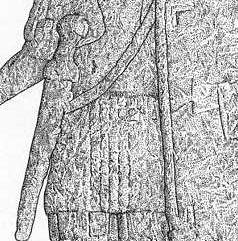 Fig. a |
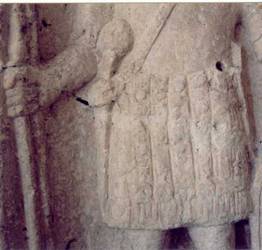 Fig. b |
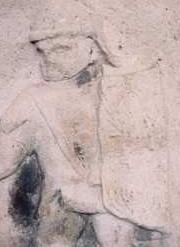 Fig. c |
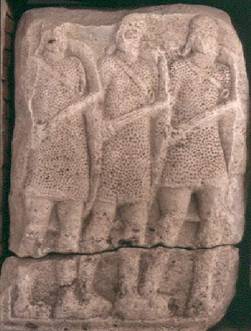 Fig. d |
|
So how do we approach emulating these two things? In the first
example, that of passing the baldric over, rather than under the
belt, since the second half of the season 2006 I have been experimenting
with this myself, as some readers will know. I had noticed the
unbelted swords some time before but had avoided doing it myself
on the basis of being worried that my sword would jump out of
its scabbard as I moved. In practice, when I bit the bullet (so
to speak) and did it, I found no significant problems. The only
problem I encountered was that following a charge, I would find
that my scabbard had worked its way around to my back. Once I
had realised this I simply had to remember to pull the scabbard
back into position before replacing my sword. Thus it ceased to
be a problem after the first time. Since then I have been wearing
my sword in this way and have become very comfortable with it.
Taken individually, none of these examples
is conclusive but taken together, the three can lend themselves
as reasonably compelling evidence for the idea of scabbards having
been buckled to their belts or baldrics. This has implications
which are relevant for the short baldric. If the baldric was fastened
to the scabbard with a buckle which was attached next to the suspension
ring of the scabbard, this would allow the baldric to be done
up over armour, and it would also make it difficult to see in
a sculpture, even if it was depicted in the first place. |
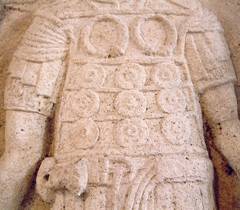 fig. e |
| Daggers Moving to daggers, there is only one problem with the way most re-enactors wear their daggers. All daggers currently carried by members of the society, as well as those of most other Roman re-enactment societies, are hung from the belt by two straps which pass through the upper suspension rings and which are then hooked over the frogs on the belt. However, a closer look at the sculptural record reveals that these straps do not appear in any known depiction of a Roman soldier. Instead, the Rhineland stelae consistently show the dagger to be suspended from the belt in such a way that the upper suspension rings (the only rings actually used) appear next to and in some cases overlapping the buttons on the frogs, indicating that it is most likely that sheaths were attached to the frogs by tying the upper suspension rings tightly to the frogs with thronging (fig.f and fig.g). This position would limit unwanted movement and is almost certainly more stable than a situation where the pugio hangs from straps some way below the frogs. Both frogs are consistently shown as being virtually in contact with the upper suspension rings on both sides. |
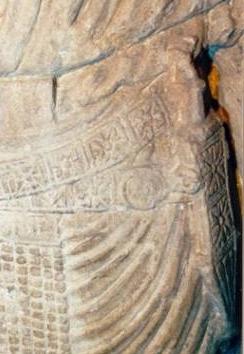 fig. f |
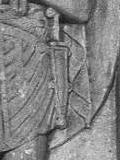 fig. g. |
| Pila The method of carrying the pilum, as most re-enactors do, with it gripped in the right hand with the thumb pointing down the shaft and resting in the crook of the arm is attested in the sculptural record but many people appear to be unaware that it may be just as correct to carry it with the thumb uppermost and the arm sharply bent, a method of carriage with is also attested in contemporary sculpture (fig.h). Presumably both methods were used and it may be that it was found useful to change the position of the hand and arm from time to time during route marches and that therefore two or more methods of gripping the pilum were employed on the march |
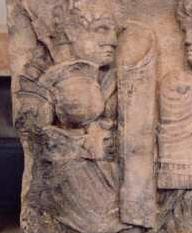 |
| Conclusion Now is the time to make the minor modifications to your baldric! When I shortened my baldric I unpicked an existing sewn join (but I would have cut it if it had been made from a continuous strap) and then donned my armour and taped the baldric together again at various lengths until I had a length which seemed about right. Once I had arrived at the desired length I simply sewed the baldric together again. If you currently have a horse harness fastener on your baldric, it really is now time to remove it, flashy though it is, and give it its own place on your mantelpiece. The baldric should be sewn up as described above. If you then undo the single strap which passes through the forward suspension ring of your sword scabbard you can draw this tighter to shorten the baldric somewhat. Similarly, if you have time, check the position of your dagger frogs. If they are positioned closely enough to each other that the sheath can sit comfortably between them, with its upper suspension rings virtually touching them then they are fine already, but if they are positioned wider apart so that the sheath's suspension rings cannot touch them on both sides then you should consider moving the frogs so that they both 'hug' the sheath. It should also be noted that the straps currently commonly used to suspend daggers should be discontinued and replaced with thronging tied tightly between the frogs and the upper suspension rings. It might also be worth trying out the alternative grip for the pilum as well. Please note that all images except figure 'd' are reproduced here courtesy of the Romanarmy.com imagebase. Figure 'd' is copyrite to Dr JCN Coulston. Addendum - Baldric fastening In line with my thoughts on baldric buckles, I would suggest that this could be achieved by fixing a small buckle to the baldric strap two or three inches from the end and bringing it close to the scabbard. The end of the baldric would be passed through the suspension ring and back to be secured onto the buckle. This would solve the problem of putting a short baldric on over armour but I would point out that there is as yet no conclusive evidence that this was the method employed. It is merely a potential solution to the problem, supported by three potential pieces of evidence and the absence of evidence for the normally assumed alternative. Crispvs |